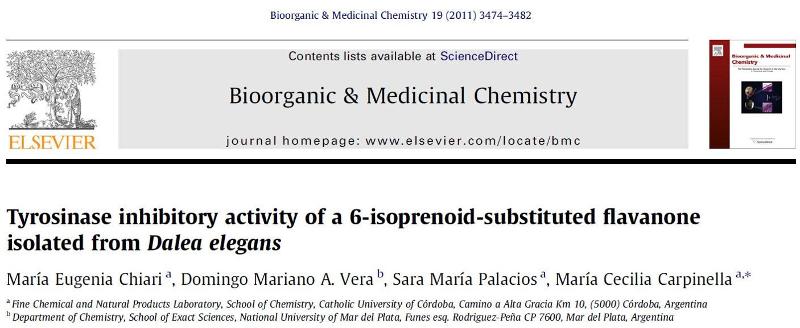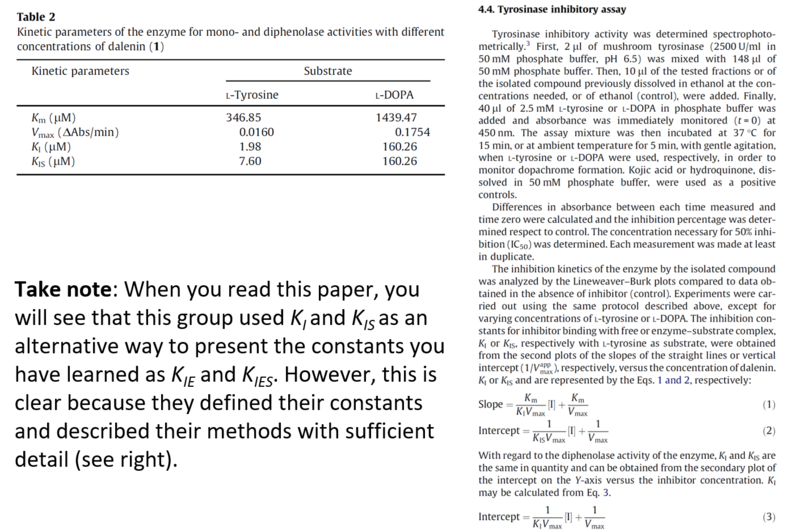|
You will present a full report of your findings on the mechanism of the tyrosinase inhibitor that you characterized. You may comment on other group's data if you wish, but you are only required to report and discuss your own data. The written report will consist of five sections: Title, Introduction, Material and Methods, Results and Discussion, and References. Additionally, you will present your calculations in Excel. |
Excel Spreadsheet
Highlight the cells containing specific sample calculations by filling those cells in yellow. The pupose of this is to help the grader find the required information. Neglecting to do this will result in points deductions. Each of the eight items below is worth 3 points.
- Clearly label substrate concentrations for your organized raw kinetics data. Do not use the stock concentrations (0.39 – 50.00 mM). Highlight the cell of one sample of calculation for a substrate dilution in yellow.
- Clearly label the slope calculations and highlight the cell of one sample calculation in yellow.
- Clearly label the relative activity calculations and highlight the one sample calcuation in yellow.
- Clearly label the values used for your Eadie-Hofstee plots and highlight one sample calculation for the x-axis in yellow.
- In your LINEST arrays, the four cells for slope, slope standard error, y-intercept, and y-intercept standard error must be highlighted in yellow.
- Clearly label and highlight in yellow the cell(s) in which you calculated your value(s) for Ki.
- Clearly label the cell containing any equation(s) used to propagate error for a derived value and highlight these cells in yellow.
- Create an organized summary of your estimates for Vmax, Vmax/Km, and Km with estimated uncertainty. If you organize these data into a formal table, you can simply cut and paste it into your writing assignment as Table 2 (see details below).
Report Title
At the top of your first page provide (1) a descriptive title of the work, (2) your name, (3) your professional email address where a reader can contact you with questions, (4) identify DePaul University as the organization you are affiated with, and (5) the date of manuscript submission.
Your title must have the detail and specificity the title of a peer-reviewed research paper. It should convey the objective of your study and mention both the enzyme and organism studied.
Introduction
Provide background for the system studied.
- Present the system being studied (mushroom tyrosinase) and provide some broader context of why this enzyme is interesting/important (must provide references).
- Provide necessary theoretical background required to understand tyrosinase. General background should include (1) a description of tyrosinase function, (2) a description of the general type of reaction(s) catalyzed by this enzyme, (3) at least one catalytic feature of the enzyme active site, (4) the natural substrates (at least one) and substrate used in this study, (5) natural products of the reaction catalyzed and the product(s) of the substrate used in this study.
- Provide additional background related to specifically to this experiment including (6) a discussion of enzyme inhibitors (at minimum discuss the one you used) and (7) SDS activation of tyrosinase by SDS.
- Make sure your facts are supported by references to literature. You may not cite the lab lessons as references. However, you are encouraged to use the references given in the lessons themselves. The PDF files are linked on the D2L Main Page. Advice on what and how to cite is given in the Citations tab of the writing guidleines.
- In Lab 4 you used Swiss-Prot and BRENDA to locate references. Consider using some of these in your introduction.
- Assume that your reader understands the elementary theory behind your methods. It is unnecessary to explain enzyme kinetics and inhibition theory in any depth in the Introduction. Instead, you will detail the data acquisition and processing steps in the Experimental section and explain your understanding of the theory in the Discussion section.
State the objective.
- Suggest an uresolved problem in the current literature that you will address then state the objective of your investigation and describe how it will help to resolve that problem.
- To help you justify the purpose of this study (there is no one correct justification), it is helpful for you to read the introductions of journal articles that report Ki values for your inhibitor. One such paper (Chiari 2011) is posted with this week's assignment on the D2L main page. From such papers, you will learn why other researchers consider tyrosinase enzyme worthy of study.
- To relate your study to other work in the field, consider your data to be a unique contribution to the current state of tyrosinase research.
- After providing general background, raise an issue that has not yet been studied in the published literature. Some ideas to consider:
- Has the Ki been reported for your inhibitor in Agaricus bispous tyrosinase? If not, your measurement is novel and can be compared to other known Ki values for your inhibitor.
- You studied the inhibition mechanism of your tyrosinase inhibitor with SDS activation. Have any tyrosinase inhibition studies been conducted with SDS activation? Would you predict that SDS changes the mechanism? Does it change the mechanism?
After you state your objectives, briefly describe the experimental design of work you will present.
- When you describe the experiment, you must mention the source organism of tyrosinase and origin of the tyrosinase that you studied (i.e. a commercial sample, an extract from a specific tissue, etc.).
- The text of an introduction should flow naturally without subsections.
- A well-written Introduction for this assignment should be less than 350 words.
- For examples, read the Writing Guidelines for guidance on the format and read the introductions of previously published journal articles that have studied tyrosinase. From these papers, you will learn why other researchers have studied tyrosinase.
Experimental
Each method you have used should have its own subheading. At the minimum, you should use the following two subheadings.
Kinetics measurements
- Describe the tyrosinase inhibition kinetics procedure in less than 250 words with the minimum critical detail required for someone to replicate your work. Identify the enzyme and its source (if you used your own enzyme extract, you should cite your own Report 1 as a technical bulletin), enzyme concentration, catechol concentration range, inhibitor concentration(s), SDS concentration, buffer composition, temperature, spectrophotometer model, wavelength, how the reactions were initiated, and what data was recorded.
Estimation of kinetics parameters
- Describe your method for calculating rates, identify software used, define CU activity units, define relative activity, include the equation for the Eadie-Hofstee transform of the Michaelis-Menten equation, describe the linear analysis method for obtaining Vmax and Km parameters from the slope and intercept, define inhibition constant(s) (Ki, Kie, and/or Kies) pertinent to your mechanism, provide the equations for calculating the inhibition constants, state the nature of uncertainty measurements (include the software function used to obtain them). All equations should be centered on their own line and numbered following the format outlined in the Data Presentation Appendix if the Writing Guidelines.
Results and Discussion
Figure 1. This figure will present representative data that demonstrates the quality of your kinetics measurements. It is the common to only provide a plot of one dataset, either the uninhibited data or the inhibitied data if the data quality is comparable. However, if one time-course dataset has significant problems, ethically, you must report the lower-quality dataset. It is acceptable to re-use Figure 1 of Assignment 4 if those data are representative. As a reminder, a good caption should identify the enzyme, substrate, inhibitor, buffer, and temperature (see the "Enzyme Kinetics Data" entry in the Methods-Captions tab of the Writing Guidelines ). No equations are necessary in the caption of this figure.
Table 1. Create a table similar to Table 1 from the Lab 5 Assignment that includes your catechol concentration (in mM) and Relative Activity (in CU/μL) data for your series of eight catechol concentrations without and with inhibitor.
Figure 2. Prepare an Eadie-Hofstee plot of the kinetics data from Table 1, make sure to include both labels and the correct units on the axes. Plot a linear trendline through your data, include equation and R2 in the caption. Your caption should also name the enzyme, temperature, buffer conditions, the substrate, the inhibitor and its concentration with the correct units, the values of your inhibition constant(s), and inhibtion mechanism.
Table 2. Create a table summarizing your estimates for Vmax, Vmax/Km, and Km for tyrosinase reaction of catechol at pH = 6.5 both with and without inhibitor. Include uncertainty for all six parameters. Identify the inhibitor and its concentration.
Results
- Remind the reader of the goals of your work. If you were successful, simply describe what you accomplished. If you have low confidence in your results or they are incomplete, state your intended objectives and make it clear your results may be inconclusive.
- Write a narrative that explains the key results of each figure and table.
- Make in-text references to every figure and table.
- Comment on the quality of your data (the quality of the trends (R2), the number of data points, the RSDs for your kinetics parmeters, etc.).
- If you do not trust your results, explain what went wrong.
- If you dropped data points, justify your decisions.
Discussion
- Analyze the statistical significance of the change in your relevant kinetics parameters with and without inhibitor in Table 2.
- Interpret this analysis to determine the mechanism of your inhibitor.
- Compare your Ki value(s) and mechanism to a literature value for tyrosinase inhibition constants reported for the same inhibitor.
- If BRENDA does not list Ki values your inhibitor in Agaricus bisporus, you should compare your values to tyrosinase in other organisms.
- Compare your catechol Km to published catechol Km values with tyrosinase in Agaricus bisporus.
- If your Km differs significantly from the literature, suggest a reason for why that might be the case.
- Include at least one literature citation in the appropriate format for each published reference value.
- As you interpret your results, be clear about the limits of your ability to interpret based on the magnitude of your uncertainty.
- Summarize whether or not you were successful in achieving your goals.
- Suggest at least one future experiment or improvement.
Submit
- A printed copy of the Lab 6 Report
- Upload to the D2L Submissions folder:
- A digital copy of the Lab 6 Report
- Your Excel Spreadsheet presented according to the instructions above
Appendix: An Example of a Published Tyrosinase Inhibition Report
(The full text is available on D2L as "Chiari 2011")
Video Lecture:

You can find morehelpful articcles like this by going to BRENDA, searching "tyrosinase", selecting "Ki" under functional parameters, and selecting papers for Agaricus bisporus.

The figures in this paper illustrate a clear and complete presentation of enzyme inhibition data. Even though this article uses the Lineweaver-Burk method of displaying their data, their clear presentation allows the reader to be aware of this, and to take the data with a grain of salt.
